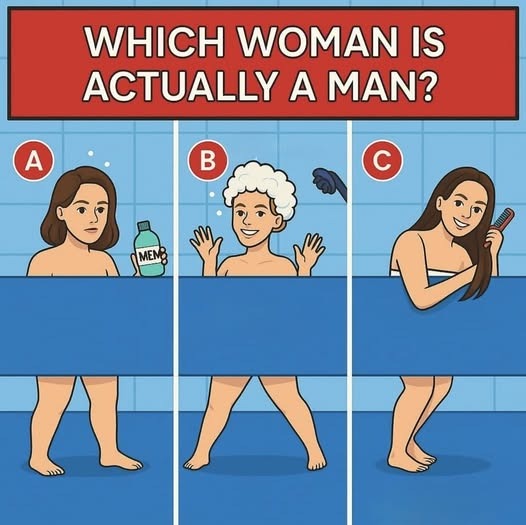There is a new mystery online, and everyone is surprised. It doesn’t seem like a huge problem that three cartoon creatures are in the shower. The picture looks fairly normal at first. They all seem like women. But there’s a twist: one of them isn’t who they say they are. You have to find out who the man in disguise is out of the three individuals.
This kind of activity evaluates our ability to tell when something feels “off” and shows us how easily our assumptions can lead us astray.
Almost everyone who sees the picture for the first time will recognize Figure A right away. Why? Because the shampoo bottle she holds says “MEN” on it. A lot of people think it looks like a clear clue, and it looks like it could spring out of the screen. We learn to connect items to gender, like shampoo for men and women. It doesn’t seem likely that a woman would use a bottle that says “men’s” on it. So, of course, most people say, “Got it!” That one has to be fake.
The person who made the puzzle wants you to believe that. It’s a distraction, like a usual case of misdirection. The big letters on the bottle are designed to catch your eye and make you think the wrong thing. It’s like a magician moving his hand to hide what he’s doing with it.
If you take a second to look past the product placement, you’ll see something important: Look at the way Figure A is standing. Her arms are close to her body, her legs are close together, and her body is bowed a little. This position makes it look like you are modest or shy. It’s delicate, quiet, and maybe even a touch shy. Body language experts and psychologists usually agree that this kind of stance suggests that a person is feminine or wants to avoid being noticed. They wouldn’t stand like way if they were trying to hide something. If anything, it matches perfectly with what someone who belongs in that scene would expect.
Next is Figure B. This is when things start to get fun. At first, nothing looks like a fake, but if you look closely, you can see little signs that something is amiss. The first thing you could notice is that the stance is wider and more stable. Figure B stands with her feet apart, which is a sign of confidence or power, and this is a sign of masculinity in body language. Her shoulders are a lot broader, and her arms hang more stiffly at her sides, which makes her look stiffer. She doesn’t look as comfortable where she is as she does in Figure A or C.
Is there something else crucial to think about? The hair, or lack of it, is a big part of it. You can’t see any hair on Figure B’s head since there is a lot of soap suds on it. In this scenario, it’s easy to see the hairstyles of the other two people. A lot of individuals wash their hair in the shower, therefore it’s not unusual for someone to have soap suds on their head. When you think of it as a puzzle, it looks like someone is trying to hide something. It looks like it doesn’t take much labor. To hide who they actually were in a cartoon like this, someone should hide their hair, especially if it looked quite different from everyone else’s.
The last one is Figure C. She may be the best person because she doesn’t get a lot of attention. Her body language is relaxed and natural. One of her legs is slightly bent, and her arms are relaxed and open. Her face is simple, but it appears calm and pleasant. There are no props that get in the way, and nothing that looks too strange. She is simply there. Getting along. That makes sense because she is most likely who she says she is.
To sum up, the shampoo bottle in Figure A might catch your eye, but her body language is normal. Figure C doesn’t set off any alarms. But what about Figure B? When you look closely at the picture, you can see the little things that stick out, such her stiff posture, soapy hair, wide stance, and so on.
This suggests she is most likely the fake person who is acting like a man.
This problem makes us think about what we think we know. We want answers right away and to trust what we see right away. The “MEN” label on the shampoo bottle is a red flag meant to throw us off, and it works—most people jump to conclusions without taking the time to look at the quieter nuances. But if you take your time and really look at the characters—how they move, how they stand, and who they are—you will find the solution.
It also tells us that our brains are continually trying to find ways to make things go faster. We use fast judgment every day to make sense of the world. We use it to figure out what’s normal, what’s not typical, and what feels right. But puzzles like this one reveal how easy it is to get lost when we don’t try hard enough.
Did the shampoo bottle trick you? Or were you one of the few who noticed the subtle signs and looked past the obvious? It’s a fun and hard puzzle to do with friends or family, no matter what. When you see a cartoon mystery or a picture online that is hard to understand, try to remember to look at how people act instead of what they say.
See who among your friends falls for the scam and who can find the true scammer lying in plain sight.


